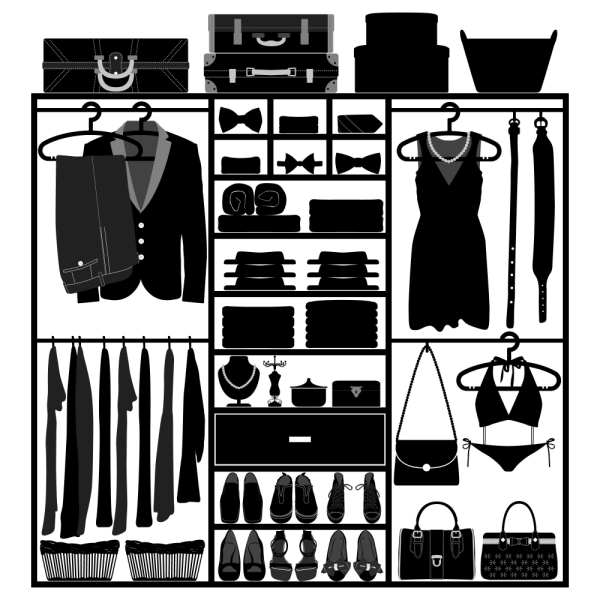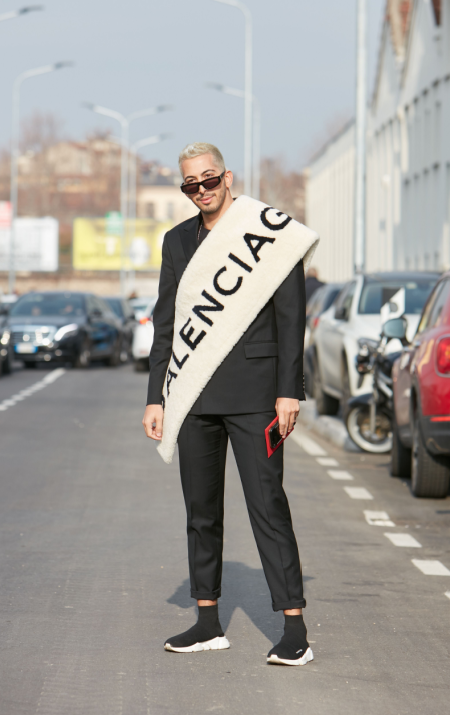Unless any given person has been fortunate enough to not be engaged with culture trends around gender & identity against societal ideas & norms, it's rather easy nowadays to consume some sort of opinion on the topic. In that simplicity however, it has been difficult to articulate my own approach in such a way that's appropriate for the scope and overall vision, not only for this website but as an overall strategy for navigating society generally. While fashion and style is ultimately a subjective transformation of one's individual expression, it simply can't be ignored that many instances throughout history have illustrated this aesthetic medium as a springboard for significant social shift. All things considered I'd rather avoid the topic altogether, but at the same time in doing so it would be a disservice to myself and this project to not express my perspective on the subject.

Honestly, minus a couple of things here and there this is an accurate illustration of my own closet
(Image credit – Shutterstock, purchased by sartorialsleaze under Standard License)
An Equal-Opportunity Closet
If I walked over to my closet at this moment I could easily pick out and grab the pieces which I would argue best encapsulate my style aesthetic. The first is a navy blue suit; neither boxy or slim-fitting, but just the right balance of sleekness & freedom of movement such that I'd equate it to both a social and corporate armor. While there's no reason to name-drop brands or labels here, let's say the cost was more than my first car...though in fairness it has stuck around with me for far longer and has been much more reliable if such a comparison could be made. From corporate environments with traditional dress codes to weddings and formal social gatherings, it was consistent as gravity time and time again.
The other item, in sharp contrast, is a premium-designer black leather pencil skirt...an armor of different sorts I suppose. Though considered taboo even in traditional social constructs, much less to wear it outside it's intended gender norm, it's versatility lended much more creativity than anticipated in my limited knowledge of fashion at time of purchase. From sneakers to stilettos, from tank tops to button-ups, and from puffers to sleek leather jackets, it ended up being a solid staple piece in my own journey to understanding the constructs of style and fashion, and how to thoughtfully deviate from them.
In the years since those purchases other garments, covering traditional male and traditional female fashion have come and gone. As much as I'd like to say that I own one of the most groundbreaking wardrobes in the history of the world, there's no way there's even an iota of truth there; from rock stars in the androgyny/glam-rock eras to other personalities in entertainment & culture, plenty have far exceeded my collections, most likely in both quality and quantity.
The Persona Evoked By Fashion...
If there's one surefire detail I can say about fashion and style generally, it's that in a lot of cases the manner in which one presents themselves can often (but not always) be a reflection of their personality. Be it in the streets, in a business setting, casual gatherings with friends and/or colleagues, and in metropolitan or suburban nightlife, fashion and style evokes a non-verbal communication to the world at-large. This aspect can be viewed positively or negatively depending on a multitude of factors, and though some may view this idea as stereotypical, it's hard to overlook historical connotation of the association of personal style being a subset of individual personality...in fact, many brands and labels in the modern era have relied on this association to sell their products.
While there's a lot of potential for discussion on a variety of fronts using the ideas above, I want to divert a bit and share a brief experience from a handful of years ago that's relevant to the overall theme of this article. I was a nightclub with some acquaintances and friends; and we were standing around talking about general stuff and things. The nightclub had a gay/lesbian theme without being exclusive/restrictive (note that this was before LGBTQIA...+ and the use of preferred pronouns was highlighted in society). Our group was loosely gathered around one of the bars in the club such that there was enough space for people to move around in-between us. As we were hanging out, an individual, assuming male, had on a minidress and Ellie or Pleaser thigh high boots with the Electra/ChaCha-style heel; for those not familiar with the brand, this particular design has a thicker 5-inch block heel that flares out at the base, accompanied with a front platform of about 1.5 inches. This individual, who in these boots stood around a height of 6'4" or 6'5" in their footwear of choice, elected to walk in-between our group, and whether intentional or not, stepped on my foot, subsequently leaving a scuff on my white leather sneakers I was wearing at the time. The detail that sticks with me to this day is that this person briefly looked down, and followed up with an I-farted-in-the-elvator-and-I-am-looking-at-you-like-you-did-it type of look. In this moment, I could only think of the line from Chris Rock's "There's No Sex in the Champagne Room":
"...if you go to a movie theater and someone steps on your foot, let it slide. Why spend the next 20 years in jail because someone scuffed your Puma!?"
Has it left an impression on me, even to this day? Absolutely. Is it representative of the idea of fashion influencing personality? Maybe, maybe not. Either way, I think so.
...And Society's Various Reactions
In the midst of this thought experiment, it would be pointless to focus solely on myself or any one individual when engaging commentary on fashion and style. Though marketing in the industry will place a lot of emphasis on the expression of individuality, the realism is that there is a balance of 'being yourself' and 'reading the room' so to speak, in that there's still expectations and social norms on how one presents themselves, depending on the setting. Honestly, this balance is not the worst thing in the world...as shown with the backlash of Balenciaga's 2022/2023 advertising, showing children with teddy bears in bondage gear, and seemingly highlighting criticism toward child pornography laws. Though this example outlines the argument from an organizational perspective versus an individual one, I think it can be said that regardless of social or political belief, it can't be denied that no matter the social stature or reputation there is a decorum specific to presentation and visual aesthetic.
That said, individual reaction and interaction can vary greatly. I can say from my own day-to-day interactions that society is mostly apathetic or focused on other things, and of the engaging ones it's usually more complementary more so than critical or spiteful. Of the inquisitive types, questions can range from, 'what are your pronouns?' to 'are you gay?', which while honestly is mildly annoying, I've found it more a reflection of pop culture and skewed social narrative rather than an accurate representation of personal interests against societal standards. This isn't to say that media entertainment is objectively wrong, but instead that it's narrowly scoped.

Think this cat’s still rocking THAT scarf in 2023!?
(Image Credit: Shutterstock, purchased by sartorialsleaze under Standard License and “Editorial Use Only” provisions. Original image attribution: andersphoto)
In Closing —
While it would be really convenient to say that in a perfect world, people could wear and express themselves however they like without criticism, there are way too many examples in which that's simply a bad idea. Though it's fair to say that even with the exponentially growing influence of social media and increased exposure to trends and ideas a given person may not otherwise see, some degree of pragmatism and decorum has to exist. Taking into account the examples outlined throughout the article, if I had to outline a fashion and style ruleset, it could look something like this:
- Regardless of traditional social norms and patterns related to personal style, any given person has the right to dictate their own decisions in their aesthetic presentation
- Within the implied right, any given person intending to exercise such a right has the following responsibilities
- Understanding cultural norms and decorum specific to a given social structure
- Being open to criticism in one's aesthetic choices
- Understanding practicality in a given environment as it relates to one's aesthetic choices
- Advocating for others without preconception, prejudice, or assumption in relation to the aesthetic choices of others
So here we are, the Sartorial Sleaze doctrine of sorts. Though imperfect on many fronts, it's a good foundation to base future content on a style and fashion blog. Perhaps it could also apply to other things, but I'm not going to get ahead of myself.